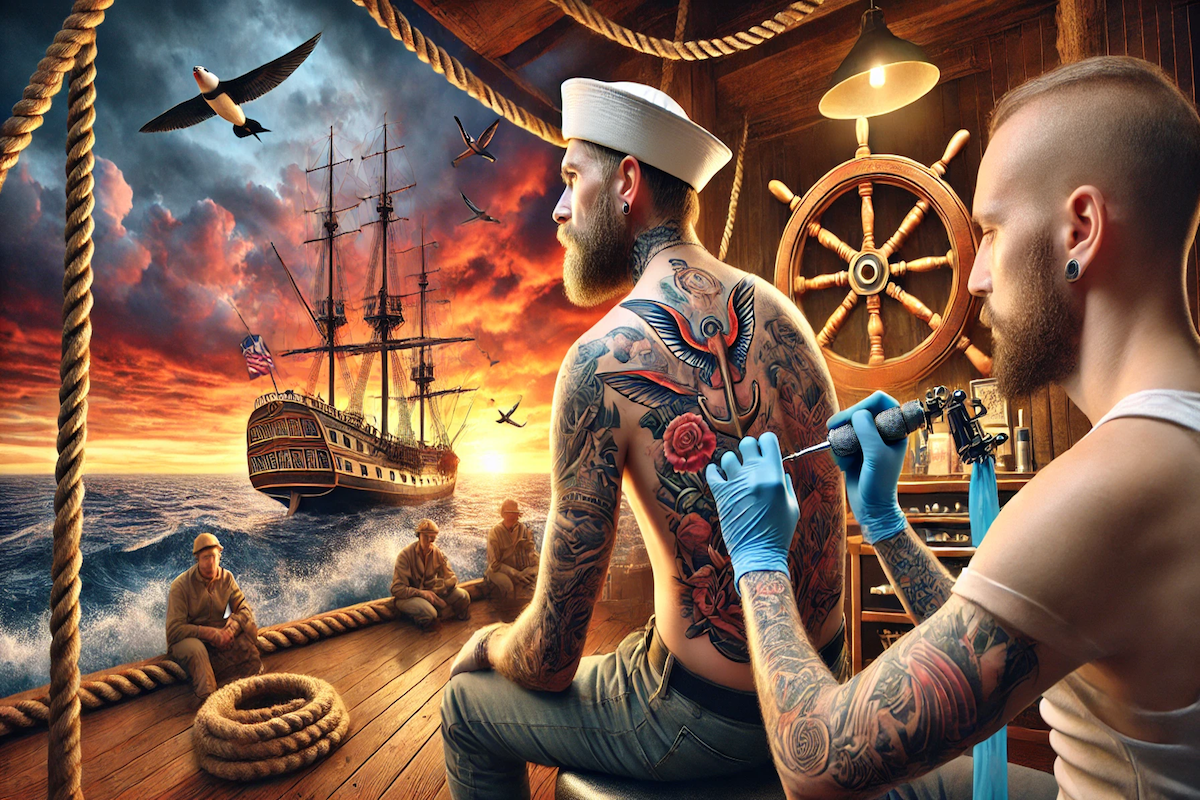Contents
- Why Sailor Tattoos Are More Than Just Ink
- A Visit to Mystic Seaport: Where Tattoo Legends Come to Life
- Tattoos as Travel Logs: The Original Wanderlust Badges
- Symbols of Survival: Anchors and Swallows
- The Barnyard Duo That Saved Lives
- Tattoos as Storybooks: Every Sailor Had a Tale
- From Ship Decks to City Streets: The Rise of Tattoo Culture
- Tattoos Meet Modern Trends: The Influence Lives On
- Places to Dive into Tattoo History
- Ink Your Legacy
Why Sailor Tattoos Are More Than Just Ink
Ever wondered why sailor tattoos remain iconic?
These designs weren’t just decoration, they were badges of survival, symbols of hope, and personal stories etched into skin.
As timeless as the ocean itself, they’ve left a mark on modern tattoo culture in more ways than one.
A Visit to Mystic Seaport: Where Tattoo Legends Come to Life
Mystic, Connecticut, is famous for two things: Julia Roberts’ 1989 movie Mystic Pizza and the Mystic Seaport Museum.
For me, it’s the museum that stands out, not for its ships, but for its tales of sailor tattoos.
During a school field trip, I wandered into an exhibit expecting dull plaques about maritime knots.
Instead, I found a treasure trove of sketches and photos, detailing how tattoos carried stories of danger, hope, and triumph on the high seas.
The museum’s artifacts revealed how tattoos weren’t just decorative—they were survival tools, personal diaries, and even spiritual shields.
Anchors etched onto skin weren’t just aesthetic; they represented stability and the promise of safe harbor.
Swallows symbolized loyalty and a sailor’s return home.
That exhibit lit a spark in me, and I realized that the history of tattoos is as vast and fascinating as the ocean itself.
Tattoos as Travel Logs: The Original Wanderlust Badges
Long before Instagram hashtags like #wanderlust or #travelgoals, how did sailors document their adventures? Tattoos.
The practice began in the late 18th century, thanks to Captain James Cook’s Pacific voyages.
His crew encountered the Polynesian art of tatau, elaborate tattoos that recorded identity, achievements, and social standing.
For sailors, this was revolutionary.
They adopted the practice to show where they’d been and what they’d survived.
By the 19th century, tattoo parlors in bustling port cities like Boston, New York, and New Orleans became hotspots for storytelling.
Sailors would swap their tales with tattooists, who turned those stories into inked art.
Each tattoo became a badge of honor: a Pacific crossing, a daring escape from pirates, or a wild night in Tahiti.
These weren’t just designs, they were proof of a life well-lived. Even today, tattoos remain a way to carry the stories of where we’ve been.
Symbols of Survival: Anchors and Swallows
Think anchors and swallows are just classic tattoo motifs? For sailors, they were much more. Swallows, for instance, were more than charming birds, they carried a sailor’s hope for a safe return.
Folklore said swallows would guide the souls of drowned sailors to the afterlife, making them powerful symbols of loyalty and protection.
Two swallows on the chest?
That meant a sailor had traveled at least 5,000 nautical miles, a true badge of honor.
Anchors were equally rich in symbolism.
To sailors, an anchor was more than a piece of hardware, it was a spiritual emblem of stability, hope, and safety.
Tattooing an anchor signified a sailor’s connection to home and the promise of safe harbors ahead.
Today, these designs remain timeless, still symbolizing journeys, loyalty, and a sense of grounding.
The Barnyard Duo That Saved Lives
Here’s a question: What do roosters and pigs have to do with not drowning? For sailors, these animals were symbols of survival.
Often transported in wooden crates, roosters and pigs were among the few creatures that floated after shipwrecks.
Sailors, always a superstitious lot, began tattooing these animals on their feet—rooster on one, pig on the other, as magical insurance against drowning.
But the life-saving ink didn’t stop there.
Many sailors added crosses on the soles of their feet, believing it would ward off sea monsters and keep their spirits from being dragged into the depths.
And the words “Hold Fast,” tattooed across the knuckles?
That wasn’t just tough-guy talk, it was a reminder to grip the rigging tightly during a storm.
Practical magic, sailor style.
Tattoos as Storybooks: Every Sailor Had a Tale
In an era before literacy was widespread, how did sailors record their lives? Tattoos. They chronicled milestones and memories, from names of sweethearts to victories at sea.
An inked ship might commemorate a Pacific crossing, while a rose symbolized undying love back home. For sailors who couldn’t write, tattoos were their personal diaries.
But tattoos weren’t just romantic or adventurous, they could be dark, too. Sailors inked reminders of lost comrades, shipwrecks, and battles, marking life’s fragility in every line.
These designs weren’t just about the past; they were badges of resilience, proof that the sailor had survived what others might not.
Today, tattoos continue to blend deeply personal stories with artistic flair, keeping this storytelling tradition alive.
From Ship Decks to City Streets: The Rise of Tattoo Culture
How did sailor tattoos move from the sea to the streets? As tattoos gained popularity among sailors, they began spreading into civilian life.
By the mid-19th century, port cities saw tattoo parlors flourish. These weren’t just places for ink—they were buzzing social hubs where mariners shared their stories.
Innovators like Sutherland Macdonald and Norman “Sailor Jerry” Collins elevated the craft, creating intricate designs with electric tattoo machines.
American traditional tattoos, characterized by bold lines, vibrant colors, and clean shading, owe their roots to these maritime traditions.
Anchors, stars, and swallows moved beyond the docks and became symbols of resilience and adventure for people everywhere.
Tattoo culture, as we know it today, began with these seafaring pioneers.
Tattoos Meet Modern Trends: The Influence Lives On
Think sailor tattoos are relics of the past? Think again. Sailor tattoos didn’t vanish, they evolved. Today, they’re re-imagined in modern styles.
Swallows appear as sleek, minimalist line art; anchors and compasses blend with watercolor effects; even the quirky rooster-and-pig duo makes its return in tattoo flash sheets.
What stays constant is their deep symbolism and connection to maritime heritage.
These designs also continue to tell stories. Just as sailors once chronicled their lives in ink, modern tattoo enthusiasts use their skin to share their journeys.
A nautical star might represent finding one’s way, while a compass could signify life’s direction.
The storytelling tradition is as strong today as it was on the high seas.
Places to Dive into Tattoo History
Want to explore the legacy of sailor tattoos firsthand? These destinations are perfect:
- Mystic Seaport Museum (Connecticut, USA): Dive into exhibits that showcase the history and artistry of sailor tattoos.
- Maritime Museum of the Atlantic (Halifax, Canada): Learn about the symbolic power of tattoos as talismans.
- National Maritime Museum (London, UK): Discover archival sketches of 18th and 19th-century sailor tattoos.
- Polynesian Cultural Center (Oahu, Hawaii, USA): Trace the Polynesian roots of tattooing and its global influence.
Ink Your Legacy
Thinking of getting a nautical tattoo? Or do you have one with a story to tell?
Sailor tattoos are more than ink, they’re symbols of resilience, superstition, and storytelling.
From the anchors of the past to the minimalist designs of today, they connect us to a rich legacy of adventure and identity.

David Peluchette is a Premium Ghostwriter/Travel and Tech Enthusiast. When David isn’t writing he enjoys traveling, learning new languages, fitness, hiking and going on long walks (did the 550 mile Camino de Santiago, not once but twice!), cooking, eating, reading and building niche websites with WordPress.

